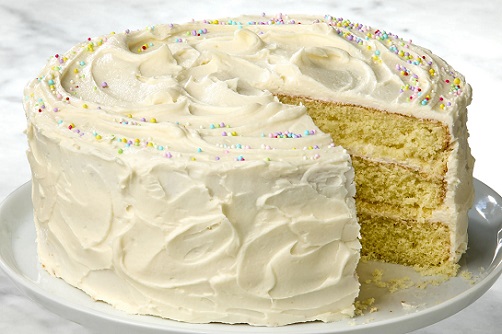Classic Vanilla Cake Recipe
The classic vanilla cake is a timeless dessert that has graced tables for generations. Its simplicity belies its ability to comfort and delight with every bite.
This recipe yields a moist, tender crumb with a delicate vanilla flavor that serves as the perfect canvas for countless variations and frostings.
Whether you’re celebrating a special occasion or simply craving a slice of homemade goodness, this vanilla cake is sure to become a staple in your baking repertoire.
The beauty of a well-made vanilla cake lies in its versatility. It can be dressed up for elegant affairs or kept simple for everyday enjoyment. The key to achieving perfection lies in quality ingredients, proper technique, and attention to detail.
This recipe has been carefully crafted to ensure consistent results, producing a cake that’s light yet substantial, sweet but not cloying, and infused with the warm, aromatic essence of pure vanilla.
As we embark on this baking journey together, remember that patience and precision are your allies. Each step, from creaming the butter and sugar to folding in the flour, plays a crucial role in developing the cake’s structure and flavor.
So, preheat your oven, gather your ingredients, and let’s create a classic vanilla cake that will have everyone asking for seconds.
Ingredients:
For the Cake:
- 2 3/4 cups (345g) all-purpose flour
- 1 1/2 teaspoons baking powder
- 1/4 teaspoon baking soda
- 1/2 teaspoon salt
- 1 cup (227g) unsalted butter, softened to room temperature
- 1 3/4 cups (350g) granulated sugar
- 4 large eggs, at room temperature
- 2 teaspoons pure vanilla extract
- 1 cup (240ml) buttermilk, at room temperature
For the Vanilla Buttercream Frosting:
- 1 cup (227g) unsalted butter, softened to room temperature
- 4 cups (480g) powdered sugar, sifted
- 1/4 cup (60ml) heavy cream
- 2 teaspoons pure vanilla extract
- 1/8 teaspoon salt
How to Make:
Prepare the Oven and Pans:
Preheat your oven to 350°F (175°C). Grease and flour two 9-inch round cake pans, or line them with parchment paper for easy removal.
Mix Dry Ingredients:
In a medium bowl, whisk together the flour, baking powder, baking soda, and salt. Set aside.
Cream Butter and Sugar:
In a large bowl using a hand mixer or stand mixer fitted with the paddle attachment, beat the softened butter on medium speed until creamy, about 1 minute. Add the granulated sugar and beat on medium-high speed for 3-4 minutes until light and fluffy. This step is crucial for incorporating air into the batter, resulting in a lighter cake texture.
Add Eggs and Vanilla:
Add the eggs one at a time, beating well after each addition. Scrape down the sides of the bowl as needed. Beat in the vanilla extract. The mixture may look slightly curdled; this is normal.
Alternate Dry Ingredients and Buttermilk:
With the mixer on low speed, add about one-third of the flour mixture to the butter mixture. Once mostly incorporated, add half the buttermilk. Repeat this process, ending with the final third of the flour mixture. Mix until just combined, being careful not to overmix.
Distribute Batter:
Divide the batter evenly between the prepared cake pans, smoothing the tops with a spatula.
Bake:
Place the pans in the preheated oven and bake for 25-30 minutes, or until a toothpick inserted into the center comes out clean or with a few moist crumbs.
Cool:
Allow the cakes to cool in the pans for 10 minutes, then turn out onto a wire rack to cool completely before frosting.
Prepare the Frosting:
While the cakes are cooling, make the buttercream. In a large bowl, beat the softened butter until creamy. Gradually add the sifted powdered sugar, alternating with the heavy cream. Beat in the vanilla extract and salt. Adjust the consistency with more cream or sugar if needed.
Frost and Decorate:
Once the cakes are completely cool, place one layer on a cake stand or serving plate. Spread a generous layer of frosting on top. Place the second layer on top and frost the entire cake with the remaining buttercream. Decorate as desired.
Chef’s Notes:
Room Temperature Ingredients: Ensure all refrigerated ingredients are at room temperature before starting. This promotes even mixing and a smoother batter.
Measuring Flour: For best results, use the spoon and level method when measuring flour. Fluff the flour, spoon it into your measuring cup, and level it off with a knife.
Creaming Technique: Don’t rush the creaming process. Properly creamed butter and sugar create a light, airy cake.
Avoid Overmixing: Once you start adding the flour, mix just until combined. Overmixing can lead to a tough, dense cake.
Even Baking: For uniform layers, weigh your batter as you divide it between the pans.
Cake Strips: For perfectly level cakes, consider using cake strips around your pans. These insulate the edges, allowing for more even baking.
Flavor Variations: Enhance the vanilla flavor by adding the seeds of a vanilla bean to the batter. For a citrus twist, add lemon or orange zest.
Storage: Store the frosted cake at room temperature for up to 3 days or in the refrigerator for up to 5 days. Bring to room temperature before serving for best flavor and texture.
Freezing: Unfrosted cake layers can be wrapped tightly and frozen for up to 3 months. Thaw overnight in the refrigerator before frosting and serving.
Nutritional Value (per serving, assuming 12 servings):
Please note that these values are approximate and can vary based on specific ingredients and portion sizes.
- Calories: 580
- Total Fat: 29g
- Saturated Fat: 18g
- Cholesterol: 120mg
- Sodium: 180mg
- Total Carbohydrates: 78g
- Dietary Fiber: 1g
- Sugars: 59g
- Protein: 5g
This classic vanilla cake is undoubtedly an indulgence, rich in calories and sugars primarily from the frosting. While it’s not a health food, it can certainly be enjoyed in moderation as part of a balanced diet. For those watching their calorie or sugar intake, consider reducing the amount of frosting used or opting for a lighter whipped cream frosting instead.
The cake does provide some nutritional benefits, including calcium and vitamin D from the dairy products used. Eggs contribute protein and various vitamins and minerals. However, due to its high sugar and fat content, this dessert should be considered an occasional treat rather than a regular part of one’s diet.
For those with dietary restrictions, this recipe can be adapted. Gluten-free all-purpose flour can be substituted for wheat flour, though the texture may vary slightly. For a dairy-free version, plant-based butter and milk alternatives can be used, keeping in mind that this will affect both the flavor and nutritional profile of the final product.
Remember, the joy of baking and sharing a homemade cake with loved ones can have its own emotional and social benefits that go beyond mere nutritional value. Enjoy your classic vanilla cake mindfully, savor each bite, and relish the moments it helps create.
Thanks for visiting Birthday Cakes Recipe


